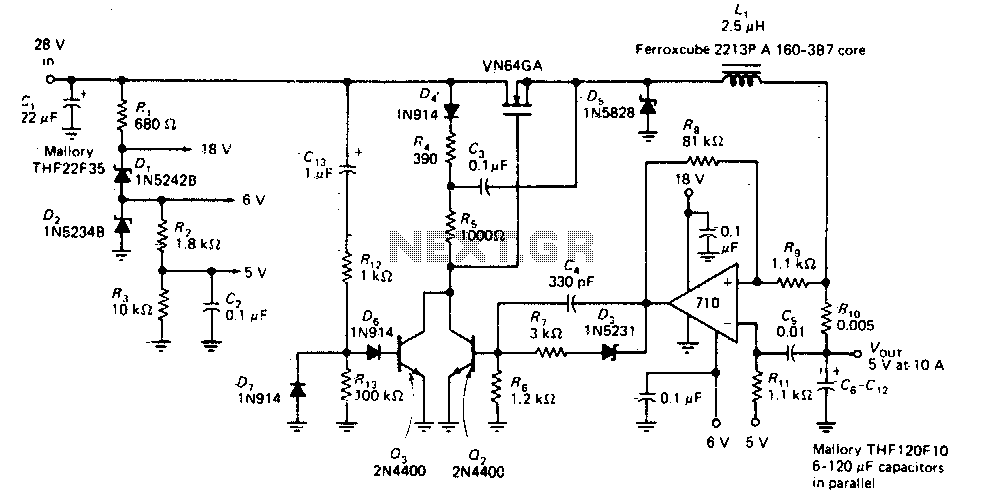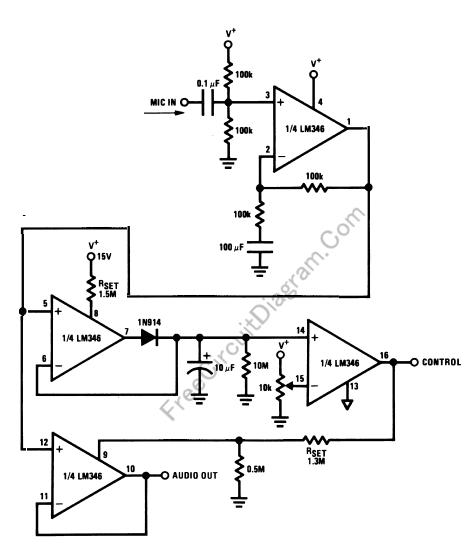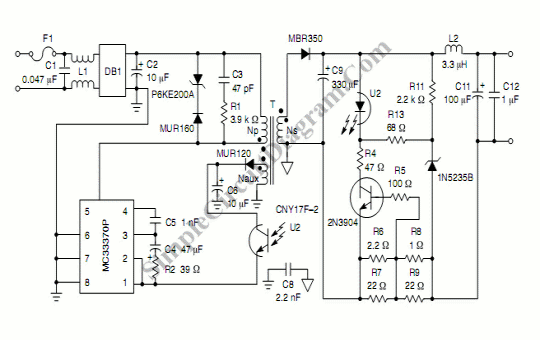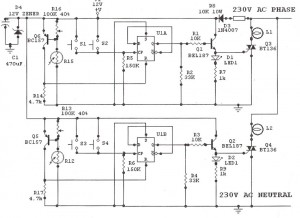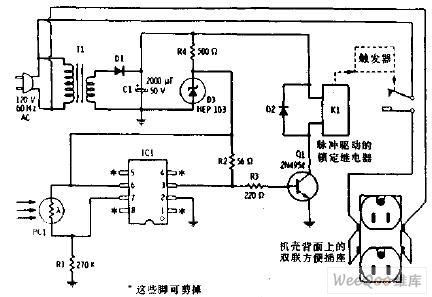
RPM switch for 6th ports or VDI
Warning: Undefined array key "extension" in /var/www/html/nextgr/view-circuit.php on line 468
Deprecated: strtolower(): Passing null to parameter #1 ($string) of type string is deprecated in /var/www/html/nextgr/view-circuit.php on line 468
A circuit diagram for an adjustable RPM switch can be utilized to activate solenoids for auxiliary ports, VDI, shift lights, or other applications. This circuit is adapted from a rev-limiter circuit designed for rotary engines. Special acknowledgment is given to Rob Weinstock from the fc3s.org list for his assistance in refining it.
Two of these switches were constructed and installed in June during a VDI swap, and they have been functioning effectively since then. The cost of parts per switch is approximately $10 CAD. It is important to note that the installed switches were mounted away from heat sources to prevent potential adverse effects on the components. Additionally, LED indicators for power and the "switched on" state were incorporated, although these are not depicted in the circuit layout.
While reviewing the S5 FSM, it was observed that the auxiliary ports and VDI only function under load conditions. In this case, a GXL model equipped with auto-adjusting suspension features a switch on the accelerator pedal that sends a 12V signal to the AAS computer when the throttle exceeds half. To simulate the "under load" effect, the 12V power for the RPM switches was derived from this switch, ensuring that they operate only when full throttle is applied. This approach may be worth considering for those undertaking a VDI swap or converting auxiliary ports to electronic activation.
The adjustable RPM switch circuit typically consists of a microcontroller or timer IC that monitors the engine RPM, a potentiometer for setting the desired RPM threshold, and output control circuitry to activate the solenoids. The microcontroller receives input from the RPM sensor and compares it against the user-defined threshold set by the potentiometer. When the RPM exceeds the threshold, the microcontroller sends a signal to the output stage, which can drive the solenoid or other connected devices.
In addition to the core components, the circuit may include protective features such as flyback diodes across the solenoid coils to prevent voltage spikes when the solenoids are deactivated. Proper grounding and power supply decoupling are essential to ensure stable operation and minimize noise in the circuit. The use of LED indicators provides visual feedback, enhancing user experience and facilitating troubleshooting.
Overall, this adjustable RPM switch circuit represents a versatile solution for various automotive applications, particularly in enhancing the functionality of auxiliary systems. Its simple design, low cost, and adaptability make it an appealing option for automotive enthusiasts looking to implement electronic control in their vehicles.A circuit diagram for an adjustable rpm switch. It ’s something you can use to activate solenoids for auxiliary ports, VDI, shift light, or anything else you can think of. The circuit is adapted from a rev-limiter circuit for rotaries. In particular, I ’d like to thank Rob Weinstock from the fc3s. org list for his help tweaking it. I built and installed two of these switches in June when I did a VDI swap, and so far they ’ve been working fine. Parts cost per switch is only about $10 CAD! Note my installed photo, I ’ve mounted them away from heat, as I don ’t know how that might affect the components.
Also, not shown in the circuit layout, I added LED indicators for power, and the ‘switched on ’ state. One other note – I had been looking at the S5 FSM, and noted that the aux. ports and VDI only operate under load. I have a GXL, which came with auto-adjusting suspension. Part of that system is a switch on the accelerator pedal, which sends a 12V signal to the AAS computer above about half throttle.
To approximate the ‘under load ’ effect, I took the 12V power for the rpm switches from this switch, so they only operate when I ‘floor it ’. Just something you might want to try if you ’re doing the VDI swap or changing your aux. ports to electronic activation. 🔗 External reference
Two of these switches were constructed and installed in June during a VDI swap, and they have been functioning effectively since then. The cost of parts per switch is approximately $10 CAD. It is important to note that the installed switches were mounted away from heat sources to prevent potential adverse effects on the components. Additionally, LED indicators for power and the "switched on" state were incorporated, although these are not depicted in the circuit layout.
While reviewing the S5 FSM, it was observed that the auxiliary ports and VDI only function under load conditions. In this case, a GXL model equipped with auto-adjusting suspension features a switch on the accelerator pedal that sends a 12V signal to the AAS computer when the throttle exceeds half. To simulate the "under load" effect, the 12V power for the RPM switches was derived from this switch, ensuring that they operate only when full throttle is applied. This approach may be worth considering for those undertaking a VDI swap or converting auxiliary ports to electronic activation.
The adjustable RPM switch circuit typically consists of a microcontroller or timer IC that monitors the engine RPM, a potentiometer for setting the desired RPM threshold, and output control circuitry to activate the solenoids. The microcontroller receives input from the RPM sensor and compares it against the user-defined threshold set by the potentiometer. When the RPM exceeds the threshold, the microcontroller sends a signal to the output stage, which can drive the solenoid or other connected devices.
In addition to the core components, the circuit may include protective features such as flyback diodes across the solenoid coils to prevent voltage spikes when the solenoids are deactivated. Proper grounding and power supply decoupling are essential to ensure stable operation and minimize noise in the circuit. The use of LED indicators provides visual feedback, enhancing user experience and facilitating troubleshooting.
Overall, this adjustable RPM switch circuit represents a versatile solution for various automotive applications, particularly in enhancing the functionality of auxiliary systems. Its simple design, low cost, and adaptability make it an appealing option for automotive enthusiasts looking to implement electronic control in their vehicles.A circuit diagram for an adjustable rpm switch. It ’s something you can use to activate solenoids for auxiliary ports, VDI, shift light, or anything else you can think of. The circuit is adapted from a rev-limiter circuit for rotaries. In particular, I ’d like to thank Rob Weinstock from the fc3s. org list for his help tweaking it. I built and installed two of these switches in June when I did a VDI swap, and so far they ’ve been working fine. Parts cost per switch is only about $10 CAD! Note my installed photo, I ’ve mounted them away from heat, as I don ’t know how that might affect the components.
Also, not shown in the circuit layout, I added LED indicators for power, and the ‘switched on ’ state. One other note – I had been looking at the S5 FSM, and noted that the aux. ports and VDI only operate under load. I have a GXL, which came with auto-adjusting suspension. Part of that system is a switch on the accelerator pedal, which sends a 12V signal to the AAS computer above about half throttle.
To approximate the ‘under load ’ effect, I took the 12V power for the rpm switches from this switch, so they only operate when I ‘floor it ’. Just something you might want to try if you ’re doing the VDI swap or changing your aux. ports to electronic activation. 🔗 External reference

